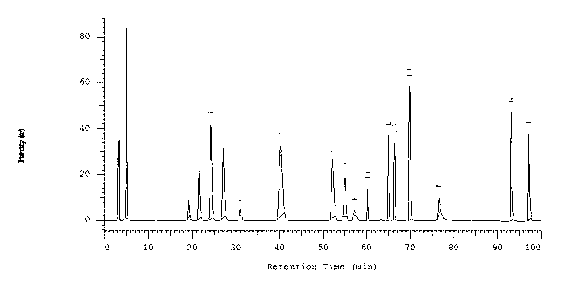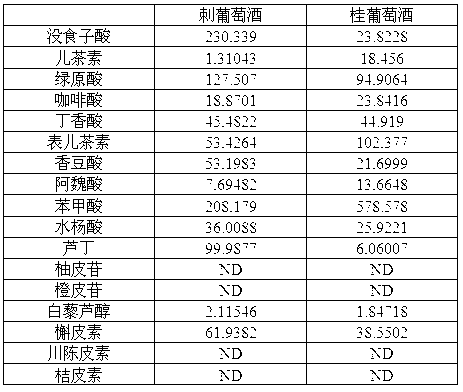Method utilizing HPLC to test seventeen phenol substances contained in grapes and oranges
A technology for phenolic substances and determination methods, applied in the field of analytical chemistry, can solve the problem of difficulty in detecting the real content, and achieve the effect of simple sample pretreatment and low cost
- Summary
- Abstract
- Description
- Claims
- Application Information
AI Technical Summary
Problems solved by technology
Method used
Image
Examples
Embodiment 1
[0022] Example 1 Determination of grape phenols
[0023] 1 Standard sample: gallic acid, catechin, epicatechin, chlorogenic acid, caffeic acid, syringic acid, coumaric acid, rutin, ferulic acid, benzoic acid, hesperidin, naringin, salicylic acid Acid, quercetin, resveratrol, nobiletin, orange peelin were purchased from sigma company.
[0024] 2 Sample pretreatment
[0025] 2-3g freeze-dried fruit sample (wine)→grinding with 50% ethanol→extracting twice with ethyl acetate→collecting the extract→concentrating to dryness under reduced pressure→dissolving in 2ml solvent (methanol:DMSO=1:1).
[0026] 3 Chromatographic conditions
[0027] Chromatographic column Merck LiChrospher_100RP18e (250mm×4.0mm); detection wavelength: 0-20min: 230nm; 20-35min: 280nm; 35-42min: 309nm; 42-60min: 320nm; column temperature: 30℃; gradient elution: mobile phase A is water: acetic acid = 98: 2; mobile phase B is acetonitrile. Elution program: 0min→100min, acetonitrile: 16%→70%, 2% acetic acid wat...
Embodiment 2
[0030] Embodiment 2 citrus peel pulp
[0031] 1 Standard sample: gallic acid, catechin, epicatechin, chlorogenic acid, caffeic acid, syringic acid, coumaric acid, rutin, ferulic acid, benzoic acid, hesperidin, naringin, salicylic acid Acid, quercetin, resveratrol, nobiletin, orange peelin were purchased from sigma company.
[0032] 2 Sample pretreatment
[0033] First, separate the pulp and peel of the sample and freeze-dry it through 60 mesh for later use; mix 0.1g sample with 1mL methanol-DMSO (V / V.50:50) for 10min at room temperature, centrifuge at 9000rpm, 15min at 4°C, repeat 3 times, and combine the supernatant In a volumetric flask, dilute to volume with methanol; filter through a 0.45 μm microporous membrane for later use.
[0034] 3 Chromatographic conditions
[0035] Column Merck LiChrospher_100RP18e (250mm×4.0mm); Detection wavelength: 0-20min: 230nm; 20-35min: 280nm; 35-42min: 309nm; 42-60min: 280nm; Column temperature: 30°C; Gradient elution: mobile phase A is...
Embodiment 3
[0038] The extraction of phenolic substance in the wine sample of embodiment 3
[0039] 1 Standard sample: gallic acid, catechin, epicatechin, chlorogenic acid, caffeic acid, syringic acid, coumaric acid, rutin, ferulic acid, benzoic acid, hesperidin, naringin, salicylic acid Acid, quercetin, resveratrol, nobiletin, orange peelin were purchased from sigma company.
[0040] 2 Sample pretreatment
[0041] Sampling and determination of monomeric phenols in wine, the extraction method is similar to that of grape fruit, the process route: wine (10 ml) → 50% ethanol extraction twice (5 times solid-liquid ratio, 70 °C extraction for 60 min) → reduced pressure concentration → Chloroform extraction 2 times→
[0042] Extract twice with ethyl acetate → concentrate under reduced pressure → extract → dissolve in methanol, dilute to 10 ml → store at 4°C for later use, repeat 3 times.
[0043] 3 Chromatographic conditions
[0044] Chromatographic column Merck LiChrospher_100RP18e (250mm...
PUM
 Login to View More
Login to View More Abstract
Description
Claims
Application Information
 Login to View More
Login to View More - R&D
- Intellectual Property
- Life Sciences
- Materials
- Tech Scout
- Unparalleled Data Quality
- Higher Quality Content
- 60% Fewer Hallucinations
Browse by: Latest US Patents, China's latest patents, Technical Efficacy Thesaurus, Application Domain, Technology Topic, Popular Technical Reports.
© 2025 PatSnap. All rights reserved.Legal|Privacy policy|Modern Slavery Act Transparency Statement|Sitemap|About US| Contact US: help@patsnap.com



